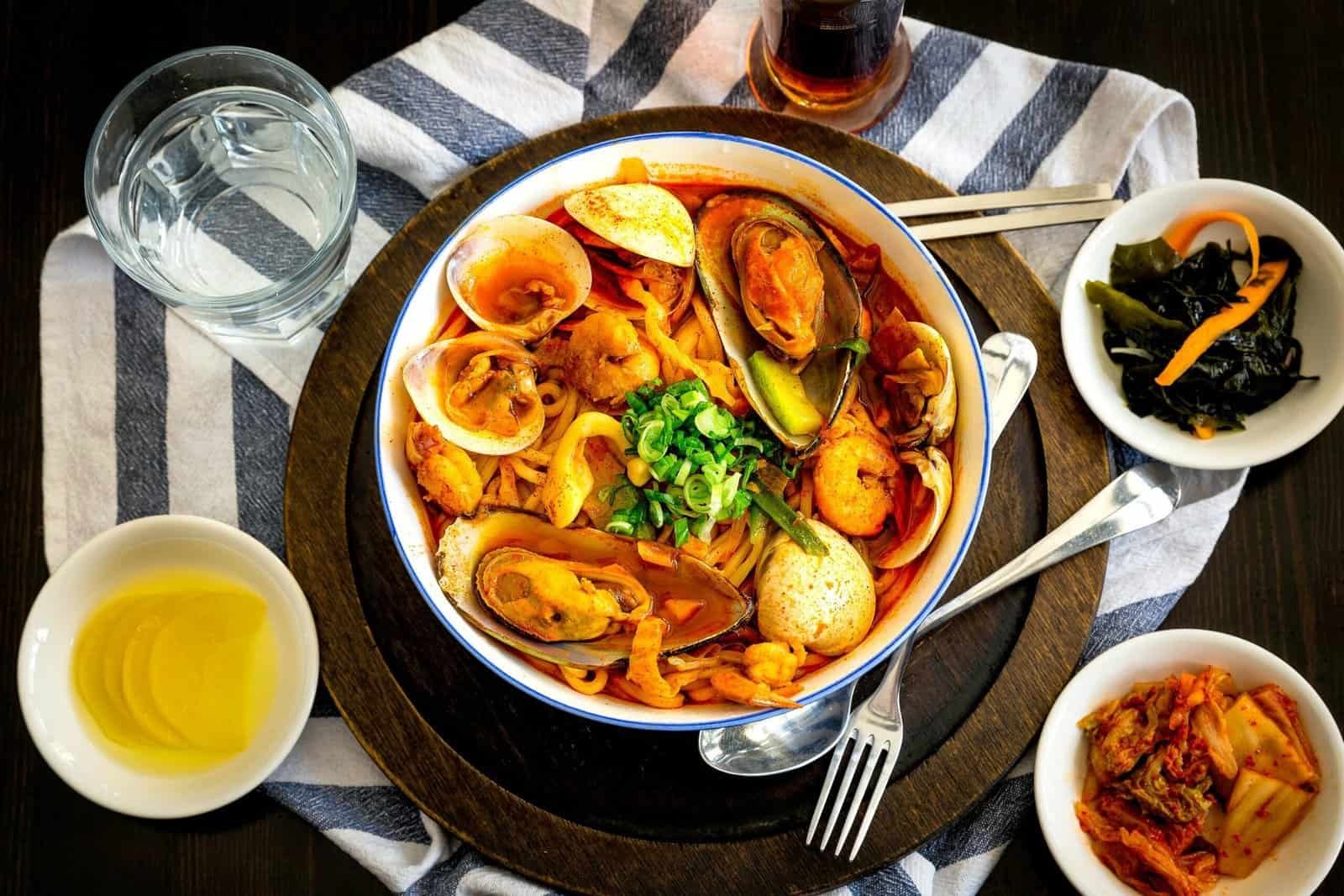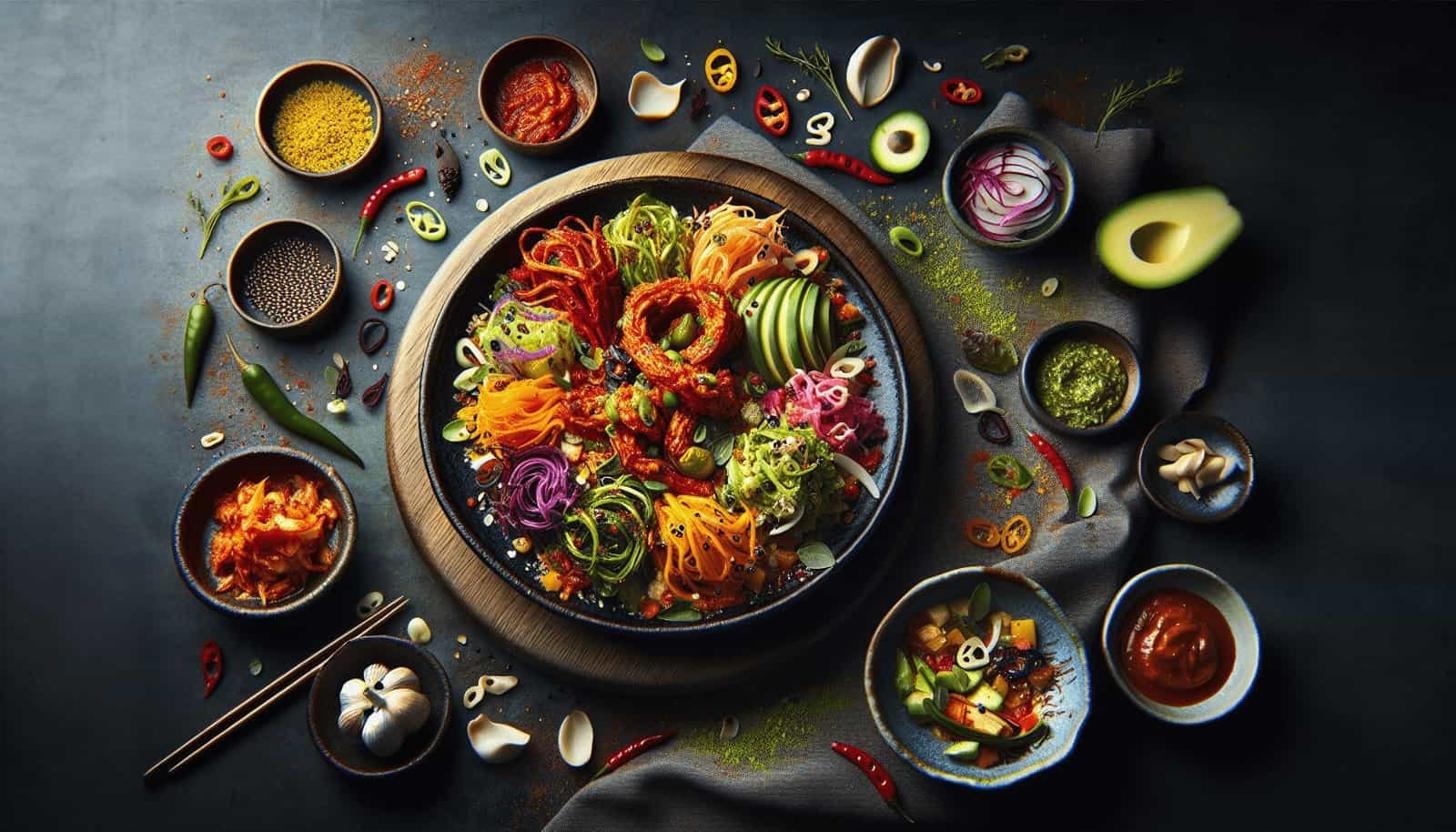Hey there! If you’re a fan of Korean cuisine but love to experiment, you’re in for a treat. In “What Are Some Modern Twists on Traditional Korean Recipes?”, you’ll discover how classic dishes like bibimbap and kimchi are being reinvented to suit contemporary tastes. From fusion flavors to inventive presentations, this article dives into the exciting world where old meets new, bringing you a delightful mix of tradition and innovation. Ready to spice up your kitchen with some cutting-edge Korean culinary creations? Let’s get cooking! Have you ever wondered how traditional Korean recipes get a fresh, modern twist? With Korean cuisine gaining global popularity, many chefs and home cooks are reimagining classic dishes to create exciting new flavors and presentations. In this article, we’ll explore some delicious modern twists on traditional Korean recipes, giving you innovative ideas to try in your own kitchen!

The Essence of Korean Cuisine
Before diving into the modern adaptations, it’s important to understand the core elements of traditional Korean cuisine. Korean dishes are known for their bold flavors, vibrant colors, and varied textures. The key ingredients often include:
- Kimchi: A staple fermented vegetable, usually cabbage or radish, seasoned with chili peppers, garlic, ginger, and other spices.
- Rice: The fundamental base for many meals.
- Soy Sauce, Garlic, and Ginger: Essential seasonings in Korean cooking.
- Gochujang: Spicy red pepper paste that adds heat and depth.
- Sesame Oil: Adds a rich, nutty flavor.
These ingredients create the backbone of many beloved Korean dishes, such as Bibimbap, Bulgogi, Japchae, and Tteokbokki. Let’s delve into how these classic recipes are being reinvented today.
Modern Bibimbap Variations
Bibimbap Sushi Rolls
What happens when you merge the beloved Korean Bibimbap with Japanese sushi? You get Bibimbap Sushi Rolls, a creative fusion that combines the best of both worlds. Instead of serving rice and vegetables in a bowl, you roll them up in nori (seaweed) sheets.
Ingredients:
- Cooked short-grain rice
- Nori sheets
- Spinach, carrots, cucumber, and radish, julienned
- Protein of choice (bulgogi, tofu, or scrambled eggs)
- Sesame oil and seeds
- Gojuchang sauce for dipping
Directions:
- Lay a nori sheet on a bamboo sushi mat.
- Spread a thin layer of rice over the nori, leaving a 1-inch border at the top.
- Arrange spinach, carrots, cucumber, radishes, and your chosen protein in horizontal lines.
- Drizzle a bit of sesame oil over the ingredients.
- Roll the nori and rice tightly using the bamboo mat.
- Cut the roll into bite-sized pieces and serve with gochujang sauce.
Kimchi Collard Green Wraps
For a healthier bibimbap option, consider Kimchi Collard Green Wraps. Instead of using rice, one can choose collard green leaves to wrap the ingredients, making it a low-carb alternative.
Ingredients:
- Collard green leaves
- A mix of fresh and pickled vegetables (carrots, radishes, cucumbers)
- Kimchi, finely chopped
- Protein of choice (chicken, tofu, or beef)
- Kimchi sauce or a spicy dressing made with gochujang
Directions:
- Blanch collard green leaves in boiling water for 20-30 seconds, then quickly cool in an ice bath.
- Lay the leaves flat and remove the thick stem in the middle.
- Place a small amount of kimchi, fresh vegetables, and protein on each leaf.
- Roll the collard greens, tucking the sides in as you go, to form a neat wrap.
- Serve with kimchi sauce or gochujang dressing.
Innovating Bulgogi
Bulgogi Tacos
Bulgogi Tacos are a classic example of Korean-Mexican fusion cuisine. By combining marinated beef with taco elements, you create a delectable treat that blends the savory flavors of bulgogi with the freshness of Mexican toppings.
Ingredients:
- Thinly sliced beef, marinated in soy sauce, garlic, ginger, sugar, and sesame oil
- Corn or flour tortillas
- Kimchi slaw (a mix of kimchi, shredded cabbage, and carrots)
- Spicy mayo (mixed from mayo and gochujang)
- Chopped green onions and cilantro for garnish
Directions:
- Cook the marinated beef in a hot skillet until fully cooked.
- Warm the tortillas on a dry skillet or in the oven.
- Assemble the tacos by placing beef on the tortillas, followed by kimchi slaw.
- Drizzle spicy mayo over the top and garnish with green onions and cilantro.
Bulgogi Pizza
Another inventive way to enjoy bulgogi is by turning it into Bulgogi Pizza. This recipe merges the comforting elements of pizza with the savory delight of bulgogi beef.
Ingredients:
- Prepared pizza dough
- Marinated bulgogi beef
- Mozzarella cheese
- Sliced bell peppers, onions, and mushrooms
- Fresh arugula and sesame seeds for garnish
- Korean BBQ sauce for drizzling
Directions:
- Preheat the oven to 450°F (230°C).
- Roll out the pizza dough on a baking sheet or pizza stone.
- Spread a thin layer of Korean BBQ sauce on the dough.
- Evenly distribute the cooked bulgogi, sliced bell peppers, onions, and mushrooms.
- Top with mozzarella cheese.
- Bake for 10-12 minutes, or until the crust is golden and the cheese is bubbly and slightly browned.
- Garnish with fresh arugula and sesame seeds before serving.
Reimagining Japchae
Japchae Spring Rolls
Japchae is a delightful dish made from glass noodles, but have you tried Japchae Spring Rolls? This interesting twist makes for a perfect appetizer or snack.
Ingredients:
- Sweet potato glass noodles (dangmyeon), cooked
- Mixed vegetables (e.g., bell peppers, spinach, carrots), sautéed
- Soy sauce and sesame oil for seasoning
- Rice paper wraps
- Dipping sauce (soy sauce, rice vinegar, and a hint of honey)
Directions:
- Toss the cooked noodles with sautéed vegetables, soy sauce, and sesame oil.
- Fill a shallow dish with warm water and briefly dip each rice paper wrap to soften.
- Place a portion of the noodle-veggie mixture onto the center of the rice paper wrap.
- Fold the sides inward and roll tightly.
- Serve with a dipping sauce made from soy sauce, rice vinegar, and honey.
Japchae Salad
For a lighter take on Japchae, try making a Japchae Salad. This dish combines the flavors and ingredients of Japchae but presents them as a fresh, vibrant salad.
Ingredients:
- Sweet potato glass noodles, cooked
- A variety of fresh vegetables (spinach, bell peppers, cucumbers, and carrots), julienned
- Protein (optional, like tofu or shrimp)
- Soy sauce, rice vinegar, sesame oil for dressing
- Toasted sesame seeds for garnish
Directions:
- Toss the cooked noodles with fresh vegetables in a large salad bowl.
- Whisk together soy sauce, rice vinegar, and sesame oil to make the dressing.
- Pour the dressing over the noodle and vegetable mixture, tossing to coat evenly.
- Add optional protein if desired and garnish with toasted sesame seeds.

Transforming Tteokbokki
Cheesy Tteokbokki
Tteokbokki, spicy Korean rice cakes, is a beloved comfort food. To give it a modern twist, how about making Cheesy Tteokbokki? The addition of melted cheese creates a decadent and indulgent dish.
Ingredients:
- Korean rice cakes (tteok)
- Gochujang and gochugaru (Korean red pepper flakes)
- Fish cakes, sliced
- Green onions, chopped
- Mozzarella cheese, shredded
- Hard-boiled eggs (optional)
Directions:
- Cook the rice cakes in water until they are soft and chewy.
- In a large pan, combine gochujang, gochugaru, and water to create a spicy sauce.
- Add the softened rice cakes, fish cakes, and green onions to the pan.
- Stir until everything is well-coated with the sauce and heated through.
- Sprinkle shredded mozzarella cheese over the top and cover until the cheese melts.
- Serve immediately, optionally adding hard-boiled eggs on the side.
Tteokbokki Mac and Cheese
Another modern take is Tteokbokki Mac and Cheese. By blending the flavors of spicy tteokbokki with the comforting elements of mac and cheese, you can create a unique and satisfying dish.
Ingredients:
- Korean rice cakes (tteok), cut into bite-sized pieces
- Pasta (elbow macaroni or similar)
- Gochujang and gochugaru
- Butter and flour (for a roux)
- Milk
- Cheddar and mozzarella cheese, shredded
- Green onions for garnish
Directions:
- Cook the rice cakes in water until soft.
- Cook the pasta according to the package instructions until al dente.
- In a saucepan, melt butter and whisk in flour to create a roux.
- Gradually add milk, stirring continuously until the mixture thickens.
- Stir in gochujang, gochugaru, and shredded cheddar cheese until smooth.
- Mix the cooked pasta and rice cakes into the cheese sauce until well-coated.
- Transfer to a baking dish, sprinkle with shredded mozzarella, and broil until the top is golden and bubbly.
- Garnish with chopped green onions before serving.
Modernizing Korean Desserts
Matcha Bingsu
Bingsu, a popular Korean shaved ice dessert, typically features sweetened condensed milk, red beans, and fruit. For a modern twist, try Matcha Bingsu.
Ingredients:
- Ice, finely shaved or crushed
- Sweetened red beans (anko)
- Fresh fruit (like strawberries or bananas), sliced
- Matcha (green tea) powder
- Sweetened condensed milk
Directions:
- Shave the ice finely and mound it in serving bowls.
- Sprinkle the matcha powder over the ice.
- Add a generous spoonful of sweetened red beans and sliced fruit.
- Drizzle sweetened condensed milk over the top and serve immediately.
Korean-Inspired Mochi Donuts
Mochi Donuts provide a chewy twist on traditional fried dough. They combine the delightful texture of mochi with the classic appeal of donuts.
Ingredients:
- Glutinous rice flour
- Regular flour
- Sugar and baking powder
- Milk
- Eggs
- Oil for frying
- Toppings like icing, matcha glaze, or powdered sugar
Directions:
- In a bowl, mix glutinous rice flour, regular flour, sugar, and baking powder.
- In a separate bowl, whisk together milk and eggs.
- Combine the wet and dry ingredients to form a dough.
- Roll the dough into small balls and shape them into rings.
- Heat oil in a fryer or deep pan and fry the dough rings until golden brown and crispy.
- Drain on paper towels and top with your choice of icing or glaze.

Fusion Korean Stews
Kimchi Jjigae with Quinoa
Kimchi Jjigae, a spicy kimchi stew, is traditionally served with rice. For a nutritious twist, try serving it with quinoa.
Ingredients:
- Kimchi, chopped
- Pork belly or tofu
- Onion and garlic
- Gochujang
- Quinoa, cooked
- Green onions for garnish
- Soy sauce and sesame oil
Directions:
- In a pot, sauté chopped kimchi, onion, and garlic until fragrant.
- Add pork belly or tofu and cook until browned.
- Stir in gochujang and cover with water.
- Simmer until the flavors meld together, about 20 minutes.
- Serve the stew over a bed of cooked quinoa.
- Garnish with green onions and a drizzle of sesame oil.
Doenjang Jjigae with Zoodles
Another stew variation is Doenjang Jjigae, traditionally made with soybean paste. Instead of serving it with rice, try Zoodles (zucchini noodles) for a lighter option.
Ingredients:
- Doenjang (fermented soybean paste)
- Vegetables (zucchini, mushrooms, onions)
- Tofu, cubed
- Zucchini, spiralized into noodles
- Garlic and green onions for flavor
- Water or vegetable broth
Directions:
- In a pot, sauté garlic and green onions until fragrant.
- Add cubed tofu and Doenjang, stirring well.
- Pour in water or vegetable broth and bring to a boil.
- Add the vegetables and simmer until tender.
- Just before serving, stir in the zucchini noodles and cook briefly until tender but still slightly firm.
Adding Korean Flair to Breakfast
Kimchi Avocado Toast
Avocado toast is a trendy breakfast option, but adding kimchi gives it a Korean twist.
Ingredients:
- Bread, toasted
- Avocado, mashed
- Kimchi, finely chopped
- Sesame seeds and green onions for garnish
- A dash of sesame oil
Directions:
- Toast the bread to your desired level of crispiness.
- Spread a generous layer of mashed avocado on the toast.
- Scatter finely chopped kimchi over the avocado.
- Drizzle with sesame oil and garnish with sesame seeds and green onions.
Gochujang Huevos Rancheros
By incorporating gochujang into Huevos Rancheros, you combine spicy Korean flavors with a beloved Mexican breakfast dish.
Ingredients:
- Corn tortillas
- Eggs
- Black beans, seasoned
- Gochujang salsa (blended tomatoes, gochujang, garlic, and onions)
- Avocado, sliced
- Fresh cilantro for garnish
Directions:
- Fry the tortillas until crispy.
- In a skillet, cook the eggs sunny side up.
- Heat and season the black beans.
- Blending tomatoes, gochujang, garlic, and onions creates the gochujang salsa.
- Assemble the dish by placing black beans on the tortilla, followed by the egg, salsa, and sliced avocado.
- Garnish with fresh cilantro.

Conclusion
The beauty of modern twists on traditional Korean recipes is the endless creativity they inspire. Whether you’re folding bibimbap into sushi rolls, topping your toast with kimchi, or blending gochujang into your breakfast dishes, there’s an exciting world of fusion food waiting to be explored. These innovations not only preserve the essence of Korean cuisine but also invite new flavors and textures, making every meal an adventure. So, next time you’re in the kitchen, don’t hesitate to experiment and bring a modern touch to your favorite Korean dishes!
What modern twist on a Korean recipe will you try next?
